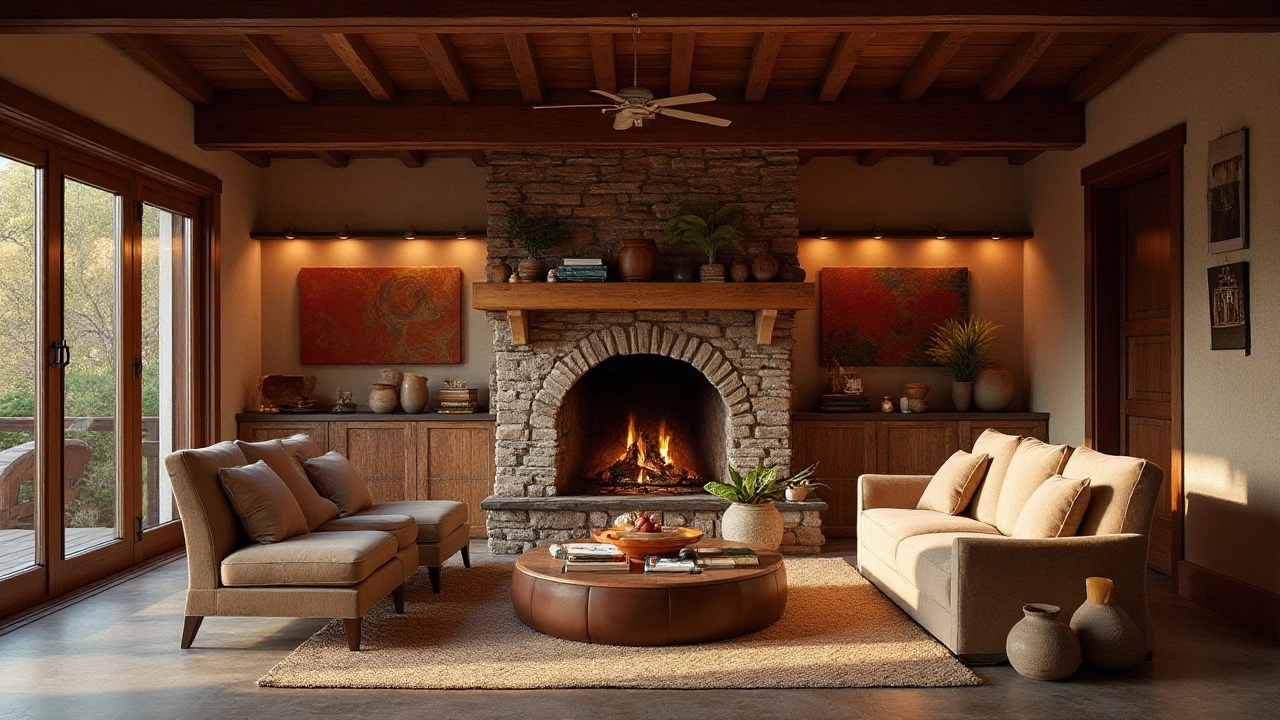In a world where design trends ebb and flow like the restless tides, the American Craftsman style stands out as a steadfast favorite. Emerging at the dawn of the 20th century, this design movement emphasized the beauty of hand-crafted details and natural materials. Its appeal transcends the fleeting nature of modern fads.
Rooted in the Arts and Crafts movement, the Craftsman style remains a canvas of simplicity and elegance. It champions artisanal quality, eschews unnecessary decoration, and embraces the warmth and character of wood, stone, and other organic materials. Today, homeowners and architects alike find joy in its harmonious blend of form and function, making it a natural fit for those seeking a cozy yet sophisticated home environment.
- History of the American Craftsman Style
- Key Characteristics of Craftsman Design
- Popular Materials Used
- Adapting Craftsman Style to Modern Homes
- Influence on Contemporary Decor
- Why Its Charm Endures
History of the American Craftsman Style
The American Craftsman style, blossoming at the dawn of the 20th century, is deeply rooted in the Arts and Crafts movement, which sprang to life in the late 19th century. This influential movement arose as a reaction to the Industrial Revolution. As machines began to dominate the production of goods, there was a yearning for a return to handcrafted artistry. In Britain, pioneers like William Morris championed the idea that craftsmanship should be both functional and beautiful, setting the stage for what would become known as the Craftsman movement across the Atlantic in America.
A pivotal figure in the story of the American Craftsman was Gustav Stickley, a designer, architect, and publisher who became one of its most vocal advocates. Stickley’s magazine, 'The Craftsman,' published from 1901 to 1916, became the voice of the movement. It featured plans for home decor, furniture, and architectural designs that emphasized simplicity, strength, and utility. Stickley's designs often showcased exposed joinery, sturdy proportions, and a lack of ornateness, tapping into the public's desire for honest, straightforward design. These ideals resonated with a growing number of Americans, leading to a proliferation of Craftsman style bungalows and furniture that have stood the test of time.
The Craftsman style found its architectural roots predominantly in residential design. Homes built in this style often featured low-pitched gabled roofs, expansive porches with thick square or round columns, and extensive use of locally sourced materials such as wood and stone. The style wasn’t just about aesthetics; it was also about creating living spaces that facilitated a simpler, more wholesome way of life. Notably, the bungalows, a signature of the Craftsman era, became an embodiment of affordability and efficiency, making homeownership a reality for many Americans. The Craftsman style was more than just architecture; it was a way of life that reflected a community-oriented, nature-focused ethos.
Los Angeles and the surrounding areas became a hotbed for these designs, where the climate and scenery supported the Craftsman ethos of blending indoor and outdoor spaces. The Gamble House in Pasadena, California, built in 1908 by architects Charles and Henry Greene, remains a stunning example of the vibrant colorations and intricate woodwork that characterize the style. Historians and craftsmen alike look to such iconic homes as benchmarks for understanding the period's craftsmanship. This house still serves as an educational resource and a source of inspiration, underlining the significance of Craftsman ideals in contemporary times.
The Craftsman style began to wane with the advent of the Great Depression and the rise of Modernism in the 1930s. Yet, it has never truly disappeared. The values of simplicity and quality remain cherished, providing a timeless appeal. In a 2023 survey by the National Association of Realtors, it was noted that homes designed in the Craftsman style continue to be among the most sought-after properties. Emphasizing craftsmanship and enduring beauty, the style holds a significant place in the narrative of American architecture and design.
This timeless architectural form remains an important part of the discourse about sustainable and meaningful design practices today. As urban life becomes increasingly hectic, many are reconnecting with the style for its promise of a peaceful, functional home. This return to traditional craftsmanship, coupled with an appreciation for natural materials and a thoughtful approach to design, suggests that the American Craftsman style will continue its legacy well into the future.
Key Characteristics of Craftsman Design
Stepping into a home styled in the American Craftsman tradition is like taking a warm embrace from history itself. This design philosophy is marked by a set of defining features that focus on artistry and functionality. At its core, the style is about celebrating the handmade and highlighting sturdy construction, creating inviting spaces that brim with character and charm. Central to this style is the emphasis on horizontal lines, intended to mimic the restful lines of the horizon. Low-pitched roofs with broad eaves are a hallmark, as they give the homes a grounded, natural feel, almost as if they are extensions of the landscapes surrounding them.
One cannot overlook the attention to detail that Craftsman homes are renowned for. These homes often feature exposed beams and rafters, which not only support the structure but add an appealing rustic element. This exposure creates visual interest, telling anyone who enters that this is a dwelling where aesthetics and structure coalesce. The use of wood is prevalent, often sourced from local forests, making each structure blend seamlessly into its environment. Spaces are defined by built-in elements such as bookcases, benches, and even fireplaces, which serve both decorative and practical purposes. In today’s world of prefabricated everything, it’s this unique, purpose-driven design that makes the Craftsman home truly stand out.
A quote that embodies the spirit of this approach comes from Gustave Stickley, a prominent figure in the Craftsman movement:
"The quiet rhythmic monotone of the wall of logs fills one with the rustic peace of a secluded nook in the woods."This eloquently captures the cozy ambiance Craftsman homes aim to achieve. Interiors often continue the theme of simplicity with open floor plans that facilitate a natural flow from room to room. Doorways and windows are typically without ornate frames, instead favoring the understated beauty of stained or leaded glass.
Every detail, from the carved wood staircase to the handmade tile work, contributes to a palette that emphasizes rich, earthy colors. The philosophy behind this is to use hues that not only warm the space but echo the natural world. Common shades include deep browns, hunter greens, and soft golds, creating a cohesive look that invites comfort. The windows themselves are often designed to maximize daylight, adding to the sense of space and openness, while always maintaining the integration with the outdoors. Through these carefully thought-out elements, the American Craftsman style doesn't merely construct homes; it crafts stories etched into wood and stone, told through the quiet poetry of its simplicity and utility.

Popular Materials Used
One cannot explore the heart of the American Craftsman style without delving into the very materials that define its unique charm. At its core, this style celebrates the natural world through the use of wood, stone, and brick — each carefully selected to enhance the sense of warmth and authenticity. The emphasis on craftsmanship means that these materials are not merely used, but showcased, with a focus on quality and detail that speaks to eras gone by.
Wood is perhaps the most beloved material in the Craftsman style, primarily due to its versatility and artisanship. Oak, in particular, stands out as a favorite choice for its durability and rich, inviting tones. Craftsman homes often feature extensive woodwork, from exposed beams to intricately constructed cabinetry, that requires not just skill but an intimate understanding of the wood itself. The grain of the wood, often prominently displayed, adds a layer of texture and visual interest that is both rustic and refined.
Another hallmark of the Craftsman design is the use of natural stone, often sourced locally, to create a seamless integration with the surrounding landscape. This material is frequently incorporated in fireplaces, foundations, and porches, providing a sense of permanence and strength. Stonework in Craftsman homes is not just functional; it’s celebrated as an art form in its own right, with each stone chosen and placed with an artist’s eye for balance and form.
"Craftsman style is about appreciating the natural and the man-made together, honoring the hands that shape these materials," says William Morris, a pivotal figure in the Arts and Crafts movement.
Brick also plays a significant role, offering both structural benefits and a warm, textured appearance. The use of brick is often most evident in the construction of fireplaces and chimneys, but also extends to the exterior facades, where it complements the other natural materials seamlessly. The appeal lies not just in the earthy color palette but in the enduring character of brickwork, which is capable of conveying both history and solidity.
A distinctive feature often found in Craftsman-style homes is the use of stained glass, integrated into windows and light fixtures, creating a play of light and color that enlivens interior spaces. This delicate element contrasts with the more robust materials like wood and stone, adding an ethereal quality that elevates the overall aesthetic. These artistic touches are not merely decorative but are designed to harmonize with the environment, enhancing the perception of craftsmanship.
The commitment to natural materials in Craftsman homes is not only about aesthetics but also sustainability, an ethos that resonates even more strongly in today's eco-conscious world. By utilizing local materials, Craftsman architecture minimizes transportation impacts and supports local economies. This aspect of the style continues to inspire modern architects and builders to create homes that are not only beautiful but in tune with their surroundings. Whether it’s the timeless elegance of oak woodwork or the rugged beauty of stone masonry, the materials of American Craftsman homes tell stories as rich and varied as the landscapes they occupy.
Adapting Craftsman Style to Modern Homes
Incorporating the timeless charm of American Craftsman design into contemporary living spaces might seem like a daunting task, yet it's an endeavor that's both rewarding and eminently doable. The key lies in harmonizing the classic features of the Craftsman tradition with the practical needs and aesthetic preferences of today's homeowners. This involves blending the old-world craftsmanship with modern conveniences, creating a living space that pays homage to its historical roots while accommodating the cadence of modern life.
One of the most significant aspects of Craftsman design is its emphasis on quality materials. This can be seamlessly integrated into modern homes by selecting building elements that echo this tradition. Picture natural wood cabinetry paired beautifully with sleek quartz countertops, or traditional beadboard paneling accentuating a minimalist open-plan space. Functional yet artistic built-ins are particularly characteristic, offering storage solutions that are both practical and visually appealing.
Embracing Open Spaces
While original Craftsman homes often exhibited more segmented room arrangements, modern adaptations favor open floor plans to foster a sense of community and flow. This can be achieved by removing unnecessary walls, yet preserving visual continuity through the use of well-placed columns or half-walls. These elements maintain the architectural integrity of the Craftsman style while embracing the spaciousness that contemporary lifestyles often demand.
The Craftsman style adapts well to modern open plans because its elements are inherently timeless and versatile. Simply simplifying the color palette and embracing uncluttered space can make all the difference.
Balancing Artistry with Technology
The juxtaposition of advanced technology with the artisanal quality of Craftsman components can create a harmonious intersection of past and present. Smart home systems discreetly integrated into Craftsman-styled woodwork can enhance functionality without diminishing aesthetic appeal. For those interested in sustainability, Craftsman homes provide an excellent framework for energy-efficient updates that are both responsible and stylish.
Ultimately, adapting the Craftsman style to a modern home requires thoughtful curation of materials, an emphasis on quality craftsmanship, and a balance between historical integrity and contemporary efficiency. This blend ensures that the design trend remains relevant not just today, but well into the future, illustrating the enduring appeal of the American Craftsman legacy.

Influence on Contemporary Decor
The impact of the American Craftsman design on contemporary decor is both profound and expansive. This style emphasizes simple, clean lines and exceptional craftsmanship, which appeals to modern sensibilities where cluttered and intricate designs often fall out of favor quickly. In the sleek modern homes seen today, the Craftsman's dedication to functionality married with artistry resonates deeply. Homeowners who desire a sense of connection with traditional values often incorporate Craftsman elements, creating a bridge between the past and the present.
One fascinating way that this influence manifests is through the use of natural materials. Modern architects and decorators are increasingly choosing materials like wood and stone, mirroring the original Craftsman's focus on organic elements. By allowing these materials to be a focal point, homes gain a warmth and authenticity that synthetic materials sometimes lack. This is not just about aesthetics; it's about creating spaces that breathe and endure, telling stories through the grain of the wood or the rough-hewn texture of stone.
Today's open-plan interiors borrow heavily from Craftsman ideals, showcasing large, yet simple spaces that are devoid of unnecessary, fluffy ornaments. This harkens back to the idea that a home should be a haven of tranquility and utility, an ethos that design trend continues to hold dear. The beauty of this approach is that it can be adapted to any scale, whether it’s a sprawling suburban home or a compact urban apartment, ensuring that each space feels welcoming and intentional.
In a world that is rapidly digitalizing, the Craftsman style's influence extends into technology integration in contemporary decor. Designers are focusing on embedding technology in a way that complements rather than clashes with traditional design elements. One might find a high-tech kitchen that seamlessly incorporates state-of-the-art appliances into handcrafted cabinetry, or living spaces where smart home features subtly enhance rather than overpower the warm ambiance created by crafted wood fixtures.
"The Craftsman style invites us to rethink our relationship with our living spaces, asking us to prioritize quality and soul over transitory fashion," commented renowned architect John Milner.
The incorporation of home decor items like Mission-style furniture, with its straight lines and exposed joinery, into modern homes is testament to the timelessness of the style. These pieces often serve as anchor elements that ground the sometimes airy nature of contemporary decor, providing both visual weight and historical context. It's as though each piece whispers stories from the past while confidently holding its place in the present, offering functional beauty that enhances daily living.
The evolution of the Craftsman style into contemporary decor also reflects a broader cultural trend towards sustainability. Today’s conscious consumers appreciate designs that are not only beautiful and functional but also respectful of our planet. Choosing designs rooted in a tradition that values endurance over ephemerality serves as a homage to nature and an investment in a more sustainable future. This shift is not just a fleeting fancy; it's an enduring transformation that aligns well with the ethos of the American Craftsman movement: build something that lasts and holds meaning generation after generation.
Why Its Charm Endures
The timeless allure of the American Craftsman style is like a gentle whisper of history echoing through the decades. It envelops its admirers in a warm embrace, blended with the spirit of simplicity and a return to nature. Its enduring presence in home design is not without reason; it symbolizes integrity and a commitment to quality that many find lacking in today's fast-paced digital world. One cannot help but admire the understated elegance that comes from letting natural woodwork take center stage, from the sleek lines and the rustic charm inherent in each piece. Each home designed in this manner tells a story, not just through its architectural details but by the ethos it represents.
What makes the American Craftsman style so eternally appealing is its respectful nod to the artistry of skilled hands, something that machine precision can rarely replicate. It celebrates not just what is seen but what is felt. As people yearn for an escape from synthetic environments, this style offers a tangible connection to a simpler, more authentic past. For many, walking into a Craftsman home is like stepping into a sanctuary where time slows down and craftsmanship claims its rightful place in the spotlight.
Some say that the Craftsman style appeals because it resonates with a collective cultural memory of home and hearth, of evenings spent by a fireplace that crackles with stories of the past. Its deep roots in the Arts and Crafts movement provide a backdrop of resistance to the industrial revolution's relentless pace, challenging the notion that faster is always better. Emphasizing human touch and intentional design over manufactured perfection gives it a soul that rings true to this day.
Architect Sarah Susanka once noted, "Craftsman design offers a counterbalance to the chaos of modern life, inviting us to slow down and appreciate the details."
Additionally, its adaptability to modern life cannot be overstated. It's an embodiment of versatility, allowing homeowners to marry traditional aesthetics with contemporary conveniences without losing its intrinsic appeal. Whether through integrating modern appliances into a historical framework or enhancing energy efficiency while maintaining architectural integrity, the style’s flexibility is its secret strength. It's not about nostalgia alone but about relevance. This ability to evolve while remaining rooted in its core principles is perhaps why this design trend is here to stay.
It's a style that embodies a rich harmony between form and function. This is why many who adopt this style opt to integrate new environmentally conscious technologies that align with the principles of sustainability, reflecting the original focus of the Craftsman style. While honoring the past, the style continues to adapt to today's needs, ensuring its message of simplicity, beauty, and integrity remains compelling.





